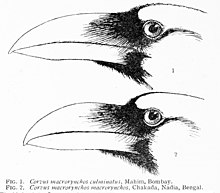Indian jungle crow
| Indian jungle crow | |
|---|---|

| |
| Adult in Mudumalai, India | |
| Scientific classification | |
| Domain: | Eukaryota |
| Kingdom: | Animalia |
| Phylum: | Chordata |
| Class: | Aves |
| Order: | Passeriformes |
| Family: | Corvidae |
| Genus: | Corvus |
| Species: | C. culminatus
|
| Binomial name | |
| Corvus culminatus Sykes, 1832
| |
| Synonyms | |
|
Corvus macrorhynchos culminatus | |
The Indian jungle crow (Corvus culminatus) is a species of crow found across the Indian Subcontinent south of the Himalayas. It is very common and readily distinguished from the
Description

This glossy all-black crow has a heavy black bill but without an arching culmen (upper edge of the mandible) and has a fine tip. The feathers have a purple gloss throughout. The tail of the Indian jungle crow is rounded and the legs and feet are stout. The base of the nape feathers is dusky.[1] The Himalayan japonensis (in this sense including western intermedius and eastern tibetosinensis) has a slightly wedge-shaped tail and a voice is a guttural and grating graak (intermedius) or a hoarse kyarrh (tibetosinensis). The calls of the Indian jungle crow are not unlike that of the house crow, but are harsher. In Sri Lanka, the house crow lacks the light grey neck, but the neck is slimmer than in the jungle crow. The sexes are indistinguishable.[2]

Taxonomy

The classification of the Asian crows has been in a state of confusion. This species was described as Corvus culminatus by Colonel W. H Sykes based on a specimen from Pune.

Ectoparasitic bird lice in the genus Myrsidea coevolve with their hosts and a study of speciation within the genus suggested distinct groups with well-marked distributions.[15] Comparisons of the vocalizations of birds from different areas also indicated clear differences[16] and analysis of sequence divergence in the mitochondrial DNA suggests that the Himalayan population (termed as japonensis by some or as intermedius+tibetosinensis by those who restrict the range of japonensis to Japan) differentiated from the plains-dwelling culminatus nearly 2 million years ago.[17][18][19]
Distribution

The Indian jungle crow is found across mainland India south of the foothills of the Himalayas, east of the desert regions of northwestern India and having an eastern limit around Bengal. It is also found in Sri Lanka.[2]
Behaviour and ecology
The Indian jungle crow is resident throughout its range. It is usually seen singly, in pairs or small groups. It is an opportunist and generalist omnivore. It may soften its food by dropping it in water,[20] and have also been observed to eat sand after feeding on meat from a carcass.[21] They have a range of cawing vocalizations. It sometimes flies with special flight styles, hoarse calls in flight or when perched with a puffed throat and accompanied by bowing movements of the head and tail dipping. The behavioural significance of these calls and postures is unknown.[14]
The breeding season is mainly March–April in northern India and earlier in southern India. In Sri Lanka, it is from May–July. The nest is a platform of twigs placed in a large tree and very rarely on buildings. The centre of the nest is neatly lined with hair, coir or other fine fibres. The usual clutch is three to five pale blue-green eggs speckled with brown. The eggs hatch after about 17–19 days and the young fledge in about a month. The nests are sometimes parasitized by the Asian koel, although not as frequently as the house crow.[22]
References
- ^ Whistler, Hugh; Kinnear, N.B. (1932). "The Vernay Scientific Survey of the Eastern Ghats (Ornithological Section)". Journal of the Bombay Natural History Society. 35: 505–524.
- ^ ISBN 8487334660.
- ^ Hume, AO (1877). "Corvus macrorhynchos, of Wagler". Stray Feathers. 5: 461–469.
- ^ Hume, AO (1889). Oates, EW (ed.). The nests and eggs of Indian birds (2nd ed.). London: R. H. Porter. pp. 4–8.
- ^ Oates, EW (1889). The Fauna of British India, Including Ceylon and Burma. Birds. Volume 1. London: Taylor and Francis. pp. 17–18.
- ^ Brooks, WE (1875). "Additional notes on birds collected between Mussoori and Gangaotri in May 1874". Stray Feathers. 3: 275–278.
- ^ Brooks, W Edwin (1875). "Notes upon a collection of birds made between Mussoori and Gangaotri in May 1874". Stray Feathers. 3: 224–257.
- JSTOR 1364435.
- ^ Baker, ECS (1922). The Fauna of British India, Including Ceylon and Burma. Birds. Volume 1 (2nd ed.). London: Taylor and Francis. pp. 25–.
- ^ Hartert, E. (1929). "Types of birds in the Tring Museum. D. The Gregory M. Mathews Collection". Novit. Zool. 35: 42–58.
- .
- ^ Whistler, H.; Kinnear, N.B. (1932). "The Vernay scientific survey of the Eastern Ghats". J. Bombay Nat. Hist. Soc. 35: 505–524.
- hdl:2246/4961.
- ^ a b Ali, S; Ripley, SD (1986). Handbook of the birds of India and Pakistan. Volume 5 (2nd ed.). New Delhi: Oxford University Press. pp. 251–258.
- .
- .
- PMID 22834756.
- .
- ^ Dickinson, E.C.; Eck, S. & Martens J. (2004). "Systematic notes on Asian birds. 44. A preliminary review of the Corvidae". Zool. Verh. Leiden. 350: 85–109.
- ^ Tehsin, Raza H. (2002). "Jungle crow Corvus macrorhynchos and its ingenuity with dry roti". Journal of the Bombay Natural History Society. 99 (1): 117–118.
- ^ Chhangani, Anil Kumar (2004). "Geophagy by three species of crows near carcass dumping ground at Jodhpur, Rajasthan". Newsletter for Ornithologists. 1 (5): 71.
- ^ Lamba, BS (1965). "The nidification of some common Indian birds-Part 2". Journal of the Bombay Natural History Society. 62 (3): 425–433.
External links
- Indian jungle crow sounds on xeno-canto.
